NRSG353 Case Study: Liver Cirrhosis - Disease, Symptoms, and Care
VerifiedAdded on 2023/04/11
|10
|1862
|118
Case Study
AI Summary
This document provides a comprehensive case study analysis of a patient diagnosed with liver cirrhosis. It begins by outlining the disease, including its causes, incidence, and risk factors, such as alcohol consumption, viral hepatitis, and drug use, and discusses the impact on the patient and their family. The case study then delves into three common signs and symptoms of cirrhosis, explaining the underlying pathophysiology of each, including easy bleeding, confusion and jaundice. The document explores the treatment options, including drug therapies like ursodiol and budesonide, and the effects of cirrhosis on pharmacokinetics and pharmacodynamics. Finally, it presents a detailed nursing care plan with goals and interventions, focusing on fluid status, nutritional needs, and patient education to manage complications and promote overall well-being. The document is a valuable resource for understanding the multifaceted aspects of liver cirrhosis and its management.

Nursing
Paraphrase This Document
Need a fresh take? Get an instant paraphrase of this document with our AI Paraphraser
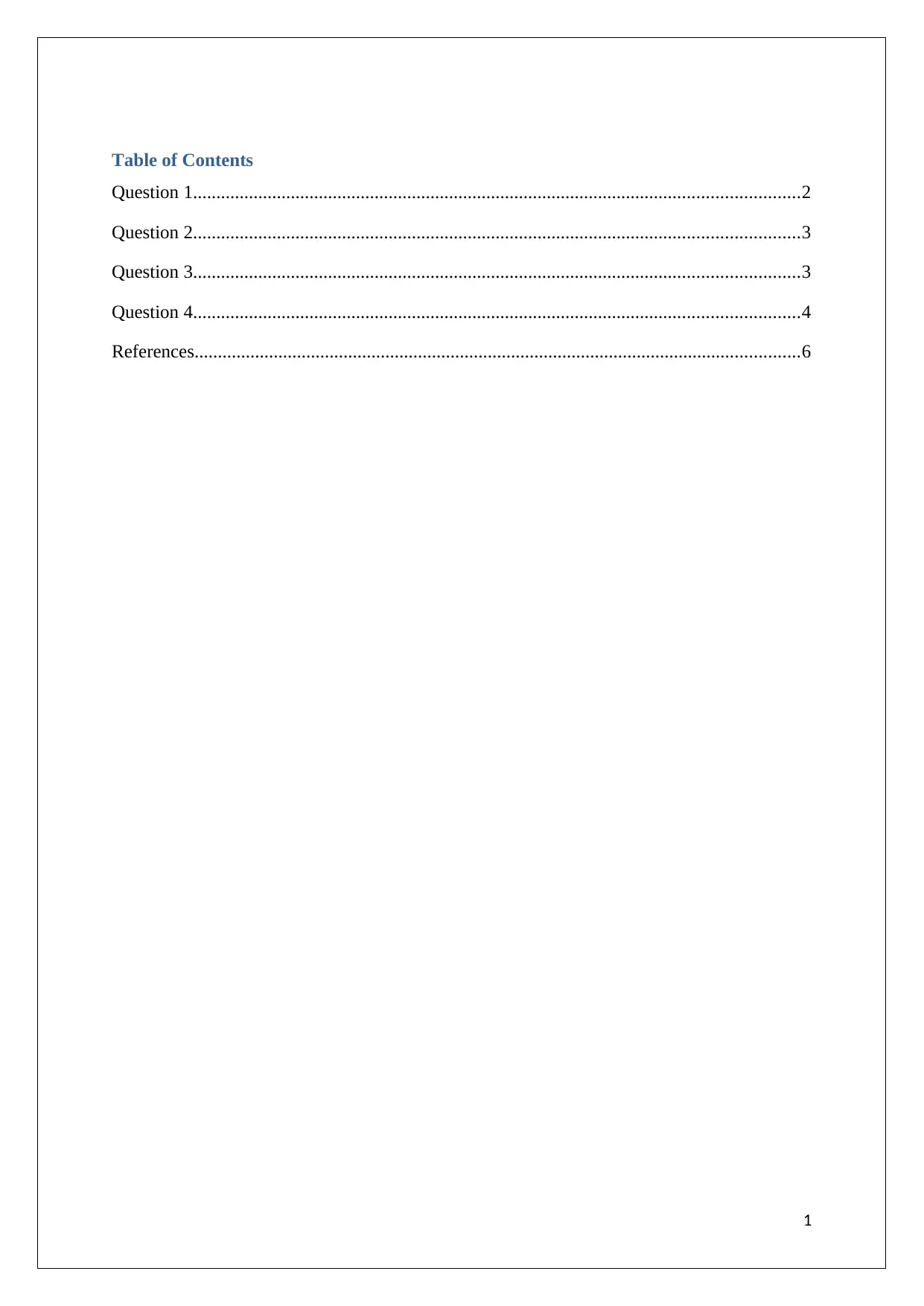
Table of Contents
Question 1..................................................................................................................................2
Question 2..................................................................................................................................3
Question 3..................................................................................................................................3
Question 4..................................................................................................................................4
References..................................................................................................................................6
1
Question 1..................................................................................................................................2
Question 2..................................................................................................................................3
Question 3..................................................................................................................................3
Question 4..................................................................................................................................4
References..................................................................................................................................6
1
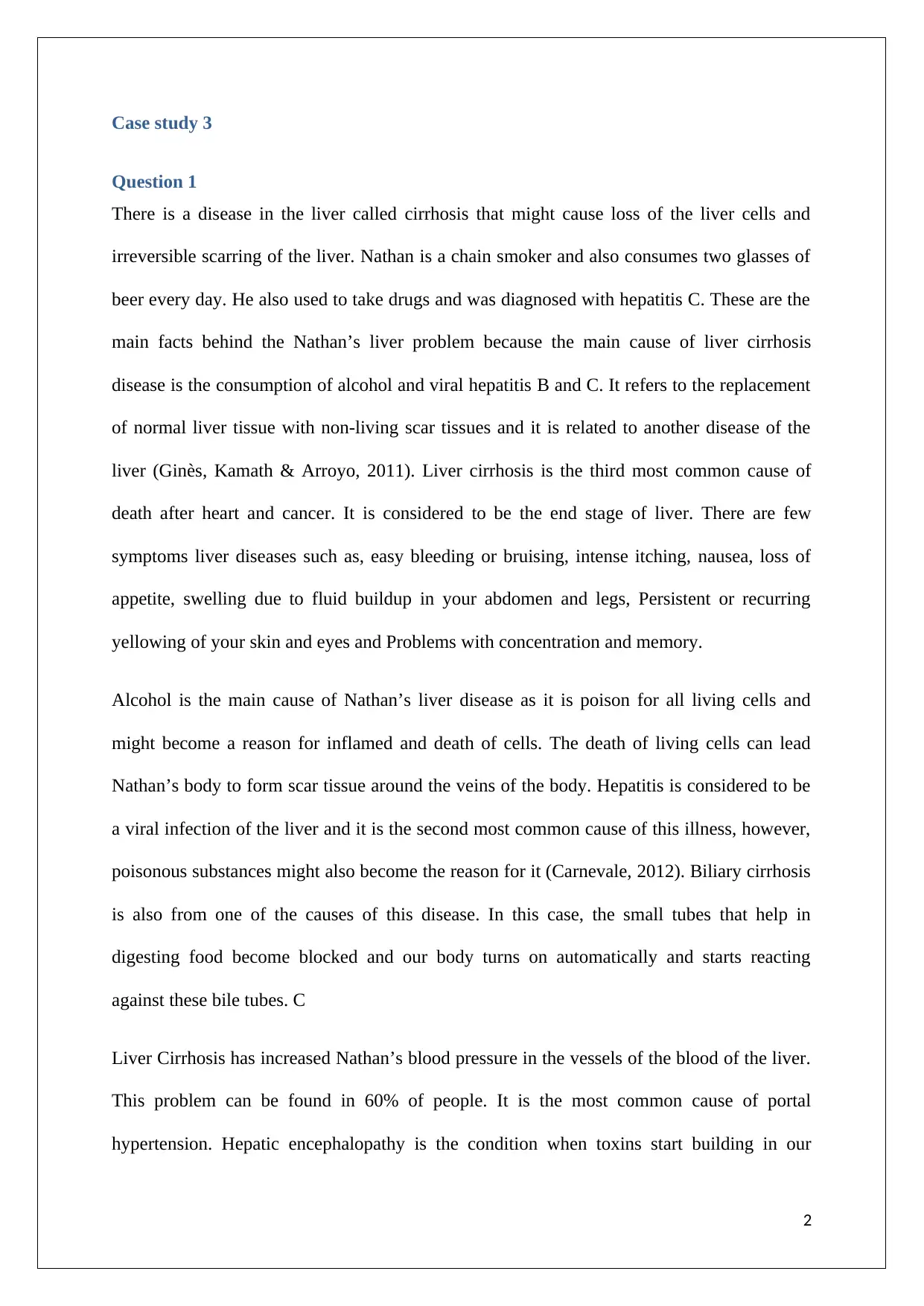
Case study 3
Question 1
There is a disease in the liver called cirrhosis that might cause loss of the liver cells and
irreversible scarring of the liver. Nathan is a chain smoker and also consumes two glasses of
beer every day. He also used to take drugs and was diagnosed with hepatitis C. These are the
main facts behind the Nathan’s liver problem because the main cause of liver cirrhosis
disease is the consumption of alcohol and viral hepatitis B and C. It refers to the replacement
of normal liver tissue with non-living scar tissues and it is related to another disease of the
liver (Ginès, Kamath & Arroyo, 2011). Liver cirrhosis is the third most common cause of
death after heart and cancer. It is considered to be the end stage of liver. There are few
symptoms liver diseases such as, easy bleeding or bruising, intense itching, nausea, loss of
appetite, swelling due to fluid buildup in your abdomen and legs, Persistent or recurring
yellowing of your skin and eyes and Problems with concentration and memory.
Alcohol is the main cause of Nathan’s liver disease as it is poison for all living cells and
might become a reason for inflamed and death of cells. The death of living cells can lead
Nathan’s body to form scar tissue around the veins of the body. Hepatitis is considered to be
a viral infection of the liver and it is the second most common cause of this illness, however,
poisonous substances might also become the reason for it (Carnevale, 2012). Biliary cirrhosis
is also from one of the causes of this disease. In this case, the small tubes that help in
digesting food become blocked and our body turns on automatically and starts reacting
against these bile tubes. C
Liver Cirrhosis has increased Nathan’s blood pressure in the vessels of the blood of the liver.
This problem can be found in 60% of people. It is the most common cause of portal
hypertension. Hepatic encephalopathy is the condition when toxins start building in our
2
Question 1
There is a disease in the liver called cirrhosis that might cause loss of the liver cells and
irreversible scarring of the liver. Nathan is a chain smoker and also consumes two glasses of
beer every day. He also used to take drugs and was diagnosed with hepatitis C. These are the
main facts behind the Nathan’s liver problem because the main cause of liver cirrhosis
disease is the consumption of alcohol and viral hepatitis B and C. It refers to the replacement
of normal liver tissue with non-living scar tissues and it is related to another disease of the
liver (Ginès, Kamath & Arroyo, 2011). Liver cirrhosis is the third most common cause of
death after heart and cancer. It is considered to be the end stage of liver. There are few
symptoms liver diseases such as, easy bleeding or bruising, intense itching, nausea, loss of
appetite, swelling due to fluid buildup in your abdomen and legs, Persistent or recurring
yellowing of your skin and eyes and Problems with concentration and memory.
Alcohol is the main cause of Nathan’s liver disease as it is poison for all living cells and
might become a reason for inflamed and death of cells. The death of living cells can lead
Nathan’s body to form scar tissue around the veins of the body. Hepatitis is considered to be
a viral infection of the liver and it is the second most common cause of this illness, however,
poisonous substances might also become the reason for it (Carnevale, 2012). Biliary cirrhosis
is also from one of the causes of this disease. In this case, the small tubes that help in
digesting food become blocked and our body turns on automatically and starts reacting
against these bile tubes. C
Liver Cirrhosis has increased Nathan’s blood pressure in the vessels of the blood of the liver.
This problem can be found in 60% of people. It is the most common cause of portal
hypertension. Hepatic encephalopathy is the condition when toxins start building in our
2
⊘ This is a preview!⊘
Do you want full access?
Subscribe today to unlock all pages.

Trusted by 1+ million students worldwide
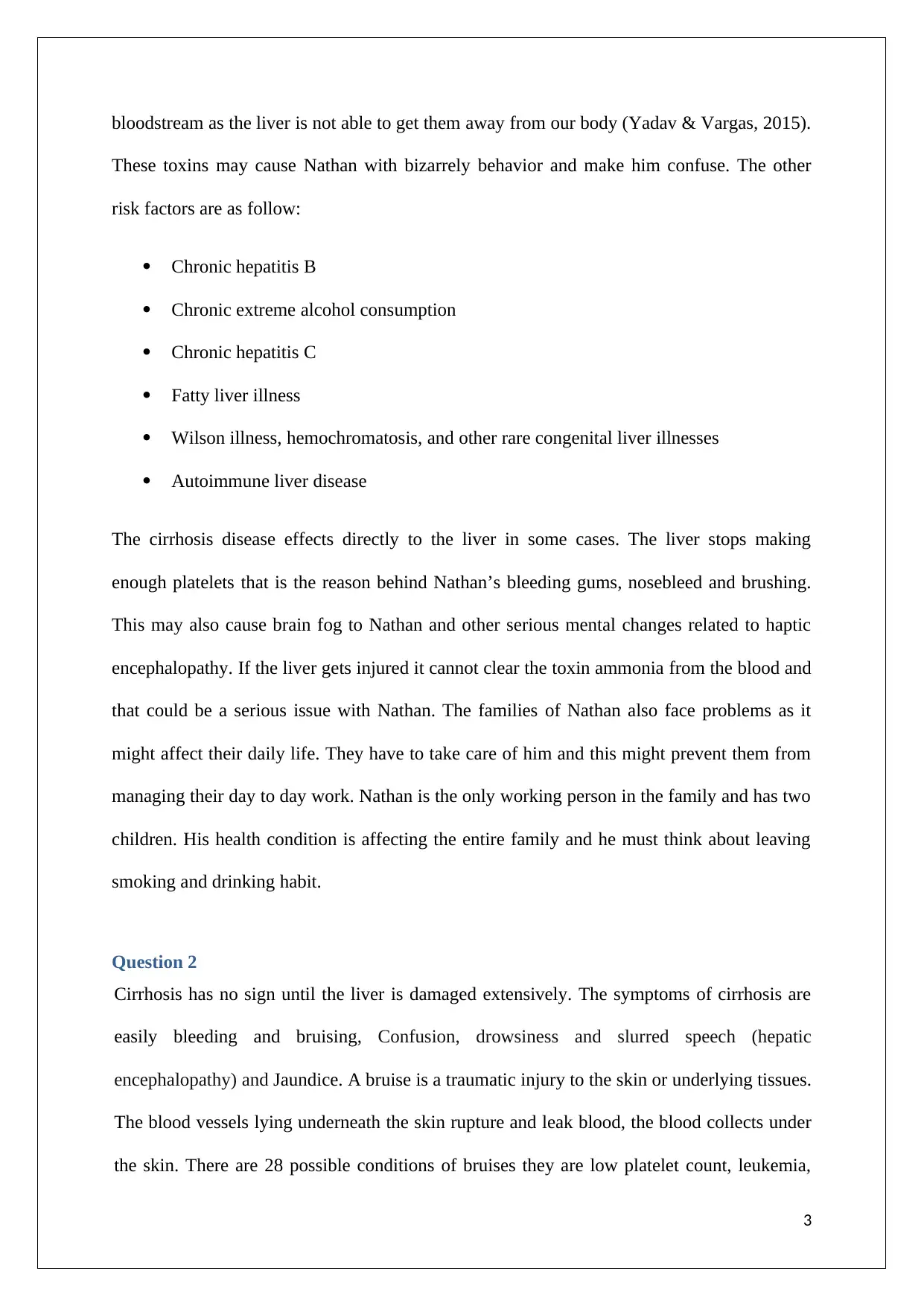
bloodstream as the liver is not able to get them away from our body (Yadav & Vargas, 2015).
These toxins may cause Nathan with bizarrely behavior and make him confuse. The other
risk factors are as follow:
Chronic hepatitis B
Chronic extreme alcohol consumption
Chronic hepatitis C
Fatty liver illness
Wilson illness, hemochromatosis, and other rare congenital liver illnesses
Autoimmune liver disease
The cirrhosis disease effects directly to the liver in some cases. The liver stops making
enough platelets that is the reason behind Nathan’s bleeding gums, nosebleed and brushing.
This may also cause brain fog to Nathan and other serious mental changes related to haptic
encephalopathy. If the liver gets injured it cannot clear the toxin ammonia from the blood and
that could be a serious issue with Nathan. The families of Nathan also face problems as it
might affect their daily life. They have to take care of him and this might prevent them from
managing their day to day work. Nathan is the only working person in the family and has two
children. His health condition is affecting the entire family and he must think about leaving
smoking and drinking habit.
Question 2
Cirrhosis has no sign until the liver is damaged extensively. The symptoms of cirrhosis are
easily bleeding and bruising, Confusion, drowsiness and slurred speech (hepatic
encephalopathy) and Jaundice. A bruise is a traumatic injury to the skin or underlying tissues.
The blood vessels lying underneath the skin rupture and leak blood, the blood collects under
the skin. There are 28 possible conditions of bruises they are low platelet count, leukemia,
3
These toxins may cause Nathan with bizarrely behavior and make him confuse. The other
risk factors are as follow:
Chronic hepatitis B
Chronic extreme alcohol consumption
Chronic hepatitis C
Fatty liver illness
Wilson illness, hemochromatosis, and other rare congenital liver illnesses
Autoimmune liver disease
The cirrhosis disease effects directly to the liver in some cases. The liver stops making
enough platelets that is the reason behind Nathan’s bleeding gums, nosebleed and brushing.
This may also cause brain fog to Nathan and other serious mental changes related to haptic
encephalopathy. If the liver gets injured it cannot clear the toxin ammonia from the blood and
that could be a serious issue with Nathan. The families of Nathan also face problems as it
might affect their daily life. They have to take care of him and this might prevent them from
managing their day to day work. Nathan is the only working person in the family and has two
children. His health condition is affecting the entire family and he must think about leaving
smoking and drinking habit.
Question 2
Cirrhosis has no sign until the liver is damaged extensively. The symptoms of cirrhosis are
easily bleeding and bruising, Confusion, drowsiness and slurred speech (hepatic
encephalopathy) and Jaundice. A bruise is a traumatic injury to the skin or underlying tissues.
The blood vessels lying underneath the skin rupture and leak blood, the blood collects under
the skin. There are 28 possible conditions of bruises they are low platelet count, leukemia,
3
Paraphrase This Document
Need a fresh take? Get an instant paraphrase of this document with our AI Paraphraser
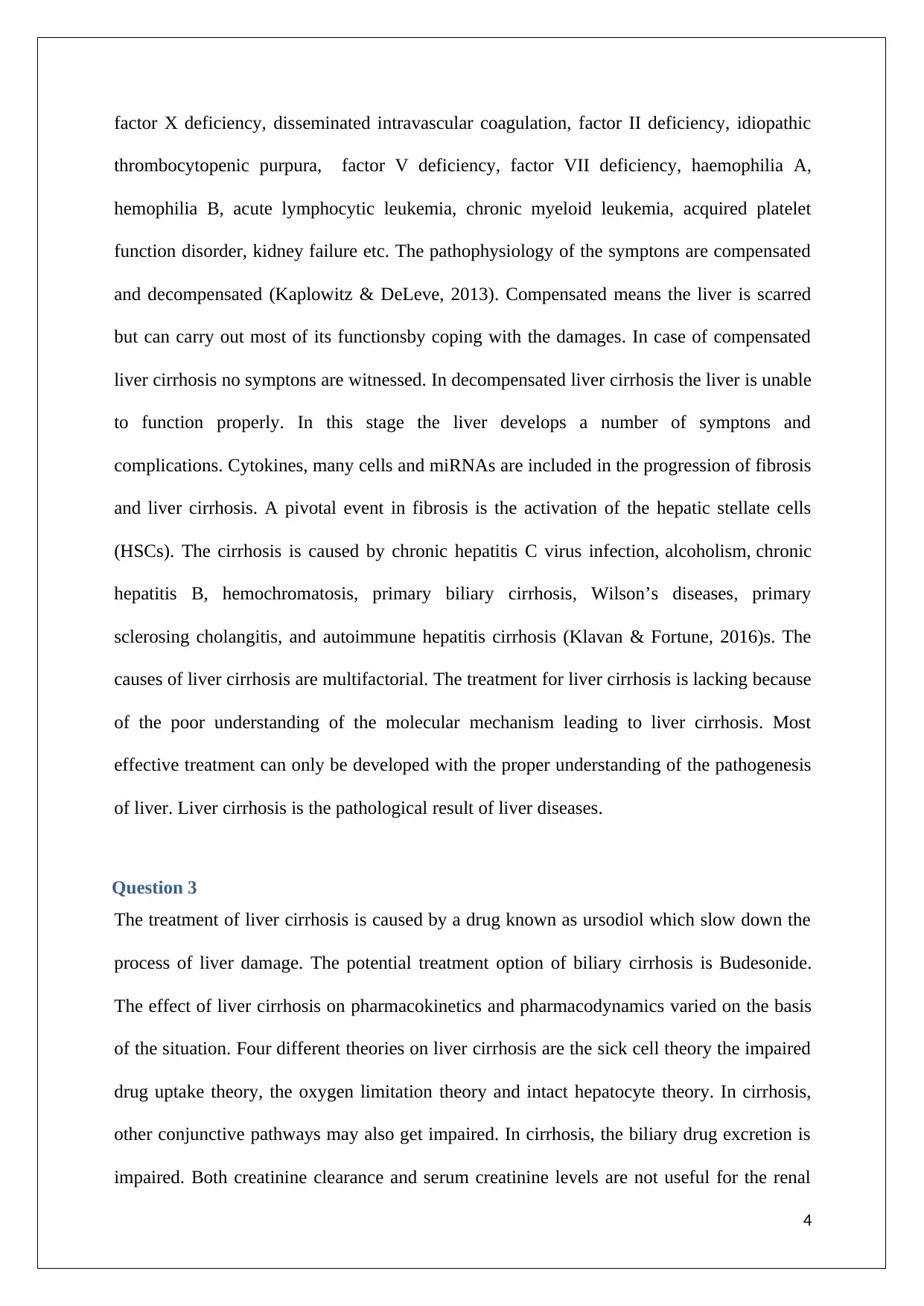
factor X deficiency, disseminated intravascular coagulation, factor II deficiency, idiopathic
thrombocytopenic purpura, factor V deficiency, factor VII deficiency, haemophilia A,
hemophilia B, acute lymphocytic leukemia, chronic myeloid leukemia, acquired platelet
function disorder, kidney failure etc. The pathophysiology of the symptons are compensated
and decompensated (Kaplowitz & DeLeve, 2013). Compensated means the liver is scarred
but can carry out most of its functionsby coping with the damages. In case of compensated
liver cirrhosis no symptons are witnessed. In decompensated liver cirrhosis the liver is unable
to function properly. In this stage the liver develops a number of symptons and
complications. Cytokines, many cells and miRNAs are included in the progression of fibrosis
and liver cirrhosis. A pivotal event in fibrosis is the activation of the hepatic stellate cells
(HSCs). The cirrhosis is caused by chronic hepatitis C virus infection, alcoholism, chronic
hepatitis B, hemochromatosis, primary biliary cirrhosis, Wilson’s diseases, primary
sclerosing cholangitis, and autoimmune hepatitis cirrhosis (Klavan & Fortune, 2016)s. The
causes of liver cirrhosis are multifactorial. The treatment for liver cirrhosis is lacking because
of the poor understanding of the molecular mechanism leading to liver cirrhosis. Most
effective treatment can only be developed with the proper understanding of the pathogenesis
of liver. Liver cirrhosis is the pathological result of liver diseases.
Question 3
The treatment of liver cirrhosis is caused by a drug known as ursodiol which slow down the
process of liver damage. The potential treatment option of biliary cirrhosis is Budesonide.
The effect of liver cirrhosis on pharmacokinetics and pharmacodynamics varied on the basis
of the situation. Four different theories on liver cirrhosis are the sick cell theory the impaired
drug uptake theory, the oxygen limitation theory and intact hepatocyte theory. In cirrhosis,
other conjunctive pathways may also get impaired. In cirrhosis, the biliary drug excretion is
impaired. Both creatinine clearance and serum creatinine levels are not useful for the renal
4
thrombocytopenic purpura, factor V deficiency, factor VII deficiency, haemophilia A,
hemophilia B, acute lymphocytic leukemia, chronic myeloid leukemia, acquired platelet
function disorder, kidney failure etc. The pathophysiology of the symptons are compensated
and decompensated (Kaplowitz & DeLeve, 2013). Compensated means the liver is scarred
but can carry out most of its functionsby coping with the damages. In case of compensated
liver cirrhosis no symptons are witnessed. In decompensated liver cirrhosis the liver is unable
to function properly. In this stage the liver develops a number of symptons and
complications. Cytokines, many cells and miRNAs are included in the progression of fibrosis
and liver cirrhosis. A pivotal event in fibrosis is the activation of the hepatic stellate cells
(HSCs). The cirrhosis is caused by chronic hepatitis C virus infection, alcoholism, chronic
hepatitis B, hemochromatosis, primary biliary cirrhosis, Wilson’s diseases, primary
sclerosing cholangitis, and autoimmune hepatitis cirrhosis (Klavan & Fortune, 2016)s. The
causes of liver cirrhosis are multifactorial. The treatment for liver cirrhosis is lacking because
of the poor understanding of the molecular mechanism leading to liver cirrhosis. Most
effective treatment can only be developed with the proper understanding of the pathogenesis
of liver. Liver cirrhosis is the pathological result of liver diseases.
Question 3
The treatment of liver cirrhosis is caused by a drug known as ursodiol which slow down the
process of liver damage. The potential treatment option of biliary cirrhosis is Budesonide.
The effect of liver cirrhosis on pharmacokinetics and pharmacodynamics varied on the basis
of the situation. Four different theories on liver cirrhosis are the sick cell theory the impaired
drug uptake theory, the oxygen limitation theory and intact hepatocyte theory. In cirrhosis,
other conjunctive pathways may also get impaired. In cirrhosis, the biliary drug excretion is
impaired. Both creatinine clearance and serum creatinine levels are not useful for the renal
4
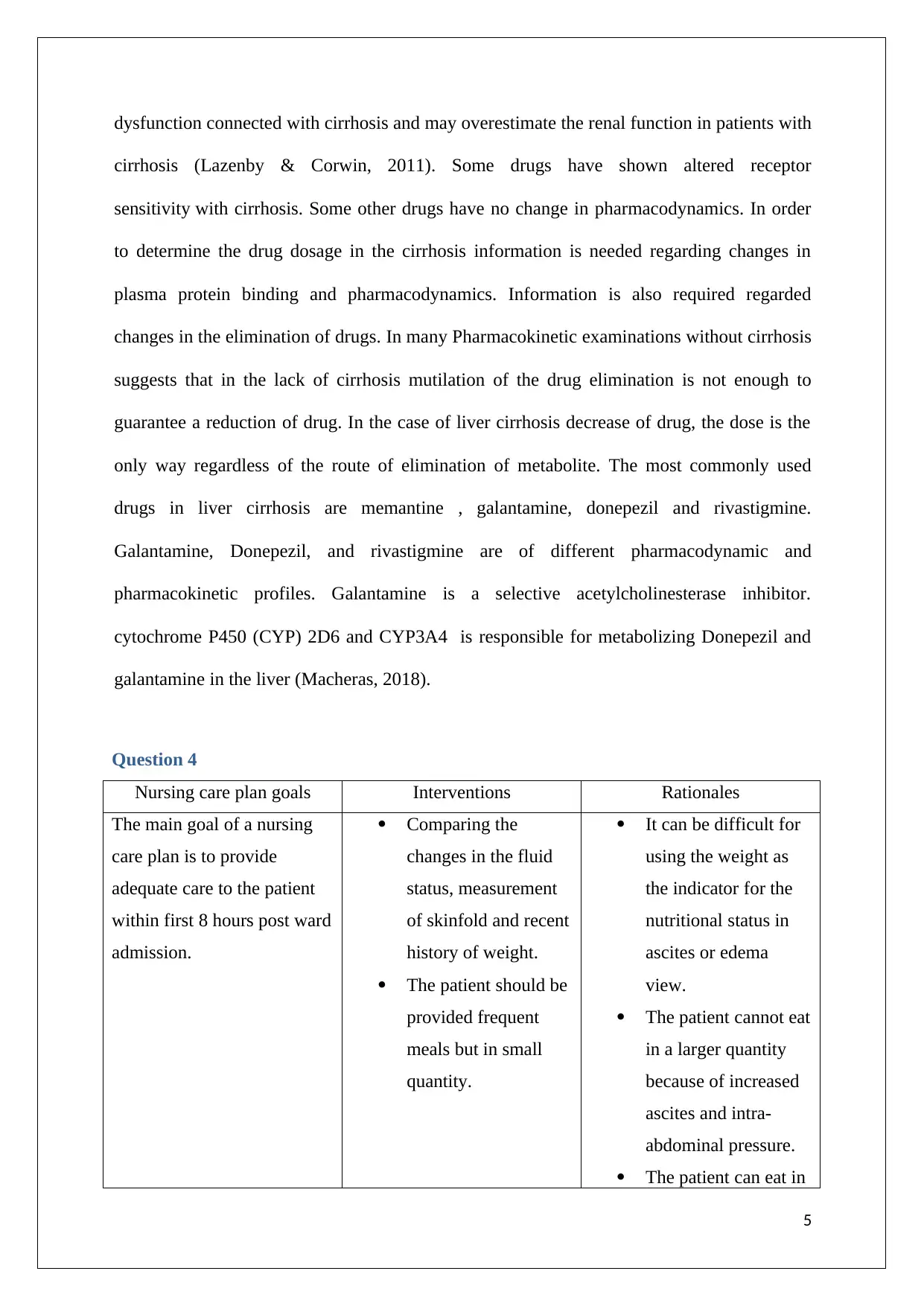
dysfunction connected with cirrhosis and may overestimate the renal function in patients with
cirrhosis (Lazenby & Corwin, 2011). Some drugs have shown altered receptor
sensitivity with cirrhosis. Some other drugs have no change in pharmacodynamics. In order
to determine the drug dosage in the cirrhosis information is needed regarding changes in
plasma protein binding and pharmacodynamics. Information is also required regarded
changes in the elimination of drugs. In many Pharmacokinetic examinations without cirrhosis
suggests that in the lack of cirrhosis mutilation of the drug elimination is not enough to
guarantee a reduction of drug. In the case of liver cirrhosis decrease of drug, the dose is the
only way regardless of the route of elimination of metabolite. The most commonly used
drugs in liver cirrhosis are memantine , galantamine, donepezil and rivastigmine.
Galantamine, Donepezil, and rivastigmine are of different pharmacodynamic and
pharmacokinetic profiles. Galantamine is a selective acetylcholinesterase inhibitor.
cytochrome P450 (CYP) 2D6 and CYP3A4 is responsible for metabolizing Donepezil and
galantamine in the liver (Macheras, 2018).
Question 4
Nursing care plan goals Interventions Rationales
The main goal of a nursing
care plan is to provide
adequate care to the patient
within first 8 hours post ward
admission.
Comparing the
changes in the fluid
status, measurement
of skinfold and recent
history of weight.
The patient should be
provided frequent
meals but in small
quantity.
It can be difficult for
using the weight as
the indicator for the
nutritional status in
ascites or edema
view.
The patient cannot eat
in a larger quantity
because of increased
ascites and intra-
abdominal pressure.
The patient can eat in
5
cirrhosis (Lazenby & Corwin, 2011). Some drugs have shown altered receptor
sensitivity with cirrhosis. Some other drugs have no change in pharmacodynamics. In order
to determine the drug dosage in the cirrhosis information is needed regarding changes in
plasma protein binding and pharmacodynamics. Information is also required regarded
changes in the elimination of drugs. In many Pharmacokinetic examinations without cirrhosis
suggests that in the lack of cirrhosis mutilation of the drug elimination is not enough to
guarantee a reduction of drug. In the case of liver cirrhosis decrease of drug, the dose is the
only way regardless of the route of elimination of metabolite. The most commonly used
drugs in liver cirrhosis are memantine , galantamine, donepezil and rivastigmine.
Galantamine, Donepezil, and rivastigmine are of different pharmacodynamic and
pharmacokinetic profiles. Galantamine is a selective acetylcholinesterase inhibitor.
cytochrome P450 (CYP) 2D6 and CYP3A4 is responsible for metabolizing Donepezil and
galantamine in the liver (Macheras, 2018).
Question 4
Nursing care plan goals Interventions Rationales
The main goal of a nursing
care plan is to provide
adequate care to the patient
within first 8 hours post ward
admission.
Comparing the
changes in the fluid
status, measurement
of skinfold and recent
history of weight.
The patient should be
provided frequent
meals but in small
quantity.
It can be difficult for
using the weight as
the indicator for the
nutritional status in
ascites or edema
view.
The patient cannot eat
in a larger quantity
because of increased
ascites and intra-
abdominal pressure.
The patient can eat in
5
⊘ This is a preview!⊘
Do you want full access?
Subscribe today to unlock all pages.

Trusted by 1+ million students worldwide
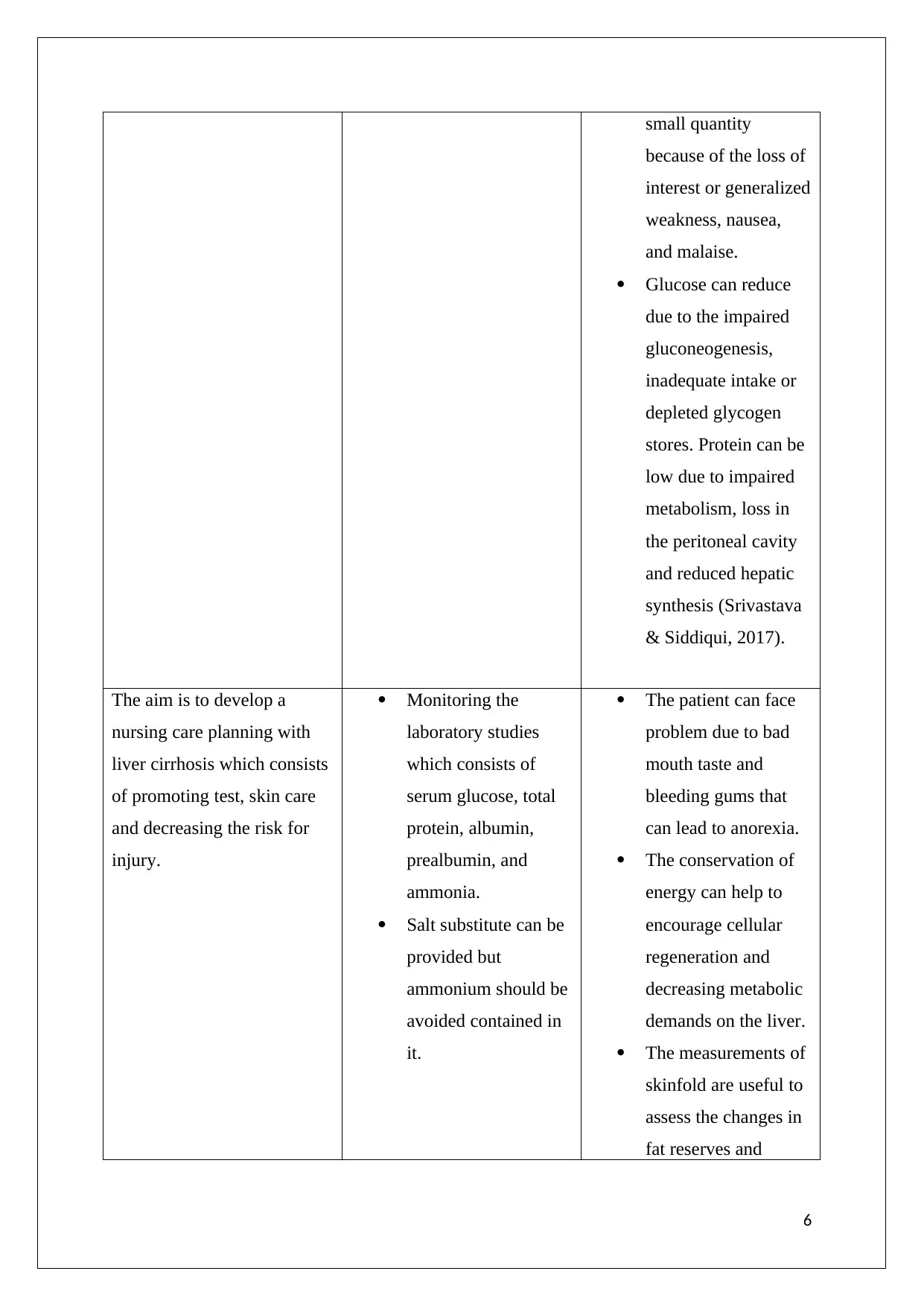
small quantity
because of the loss of
interest or generalized
weakness, nausea,
and malaise.
Glucose can reduce
due to the impaired
gluconeogenesis,
inadequate intake or
depleted glycogen
stores. Protein can be
low due to impaired
metabolism, loss in
the peritoneal cavity
and reduced hepatic
synthesis (Srivastava
& Siddiqui, 2017).
The aim is to develop a
nursing care planning with
liver cirrhosis which consists
of promoting test, skin care
and decreasing the risk for
injury.
Monitoring the
laboratory studies
which consists of
serum glucose, total
protein, albumin,
prealbumin, and
ammonia.
Salt substitute can be
provided but
ammonium should be
avoided contained in
it.
The patient can face
problem due to bad
mouth taste and
bleeding gums that
can lead to anorexia.
The conservation of
energy can help to
encourage cellular
regeneration and
decreasing metabolic
demands on the liver.
The measurements of
skinfold are useful to
assess the changes in
fat reserves and
6
because of the loss of
interest or generalized
weakness, nausea,
and malaise.
Glucose can reduce
due to the impaired
gluconeogenesis,
inadequate intake or
depleted glycogen
stores. Protein can be
low due to impaired
metabolism, loss in
the peritoneal cavity
and reduced hepatic
synthesis (Srivastava
& Siddiqui, 2017).
The aim is to develop a
nursing care planning with
liver cirrhosis which consists
of promoting test, skin care
and decreasing the risk for
injury.
Monitoring the
laboratory studies
which consists of
serum glucose, total
protein, albumin,
prealbumin, and
ammonia.
Salt substitute can be
provided but
ammonium should be
avoided contained in
it.
The patient can face
problem due to bad
mouth taste and
bleeding gums that
can lead to anorexia.
The conservation of
energy can help to
encourage cellular
regeneration and
decreasing metabolic
demands on the liver.
The measurements of
skinfold are useful to
assess the changes in
fat reserves and
6
Paraphrase This Document
Need a fresh take? Get an instant paraphrase of this document with our AI Paraphraser
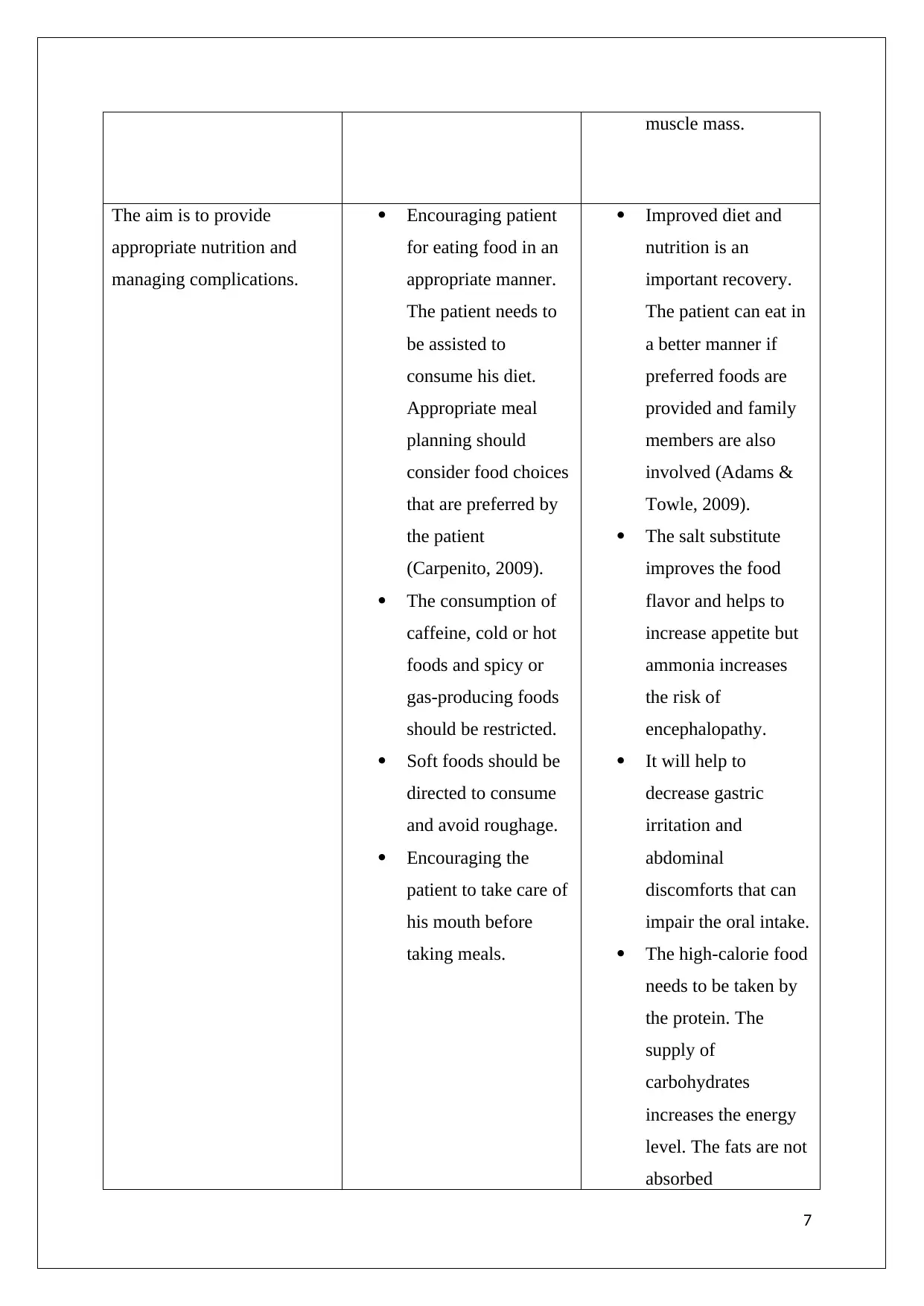
muscle mass.
The aim is to provide
appropriate nutrition and
managing complications.
Encouraging patient
for eating food in an
appropriate manner.
The patient needs to
be assisted to
consume his diet.
Appropriate meal
planning should
consider food choices
that are preferred by
the patient
(Carpenito, 2009).
The consumption of
caffeine, cold or hot
foods and spicy or
gas-producing foods
should be restricted.
Soft foods should be
directed to consume
and avoid roughage.
Encouraging the
patient to take care of
his mouth before
taking meals.
Improved diet and
nutrition is an
important recovery.
The patient can eat in
a better manner if
preferred foods are
provided and family
members are also
involved (Adams &
Towle, 2009).
The salt substitute
improves the food
flavor and helps to
increase appetite but
ammonia increases
the risk of
encephalopathy.
It will help to
decrease gastric
irritation and
abdominal
discomforts that can
impair the oral intake.
The high-calorie food
needs to be taken by
the protein. The
supply of
carbohydrates
increases the energy
level. The fats are not
absorbed
7
The aim is to provide
appropriate nutrition and
managing complications.
Encouraging patient
for eating food in an
appropriate manner.
The patient needs to
be assisted to
consume his diet.
Appropriate meal
planning should
consider food choices
that are preferred by
the patient
(Carpenito, 2009).
The consumption of
caffeine, cold or hot
foods and spicy or
gas-producing foods
should be restricted.
Soft foods should be
directed to consume
and avoid roughage.
Encouraging the
patient to take care of
his mouth before
taking meals.
Improved diet and
nutrition is an
important recovery.
The patient can eat in
a better manner if
preferred foods are
provided and family
members are also
involved (Adams &
Towle, 2009).
The salt substitute
improves the food
flavor and helps to
increase appetite but
ammonia increases
the risk of
encephalopathy.
It will help to
decrease gastric
irritation and
abdominal
discomforts that can
impair the oral intake.
The high-calorie food
needs to be taken by
the protein. The
supply of
carbohydrates
increases the energy
level. The fats are not
absorbed
7
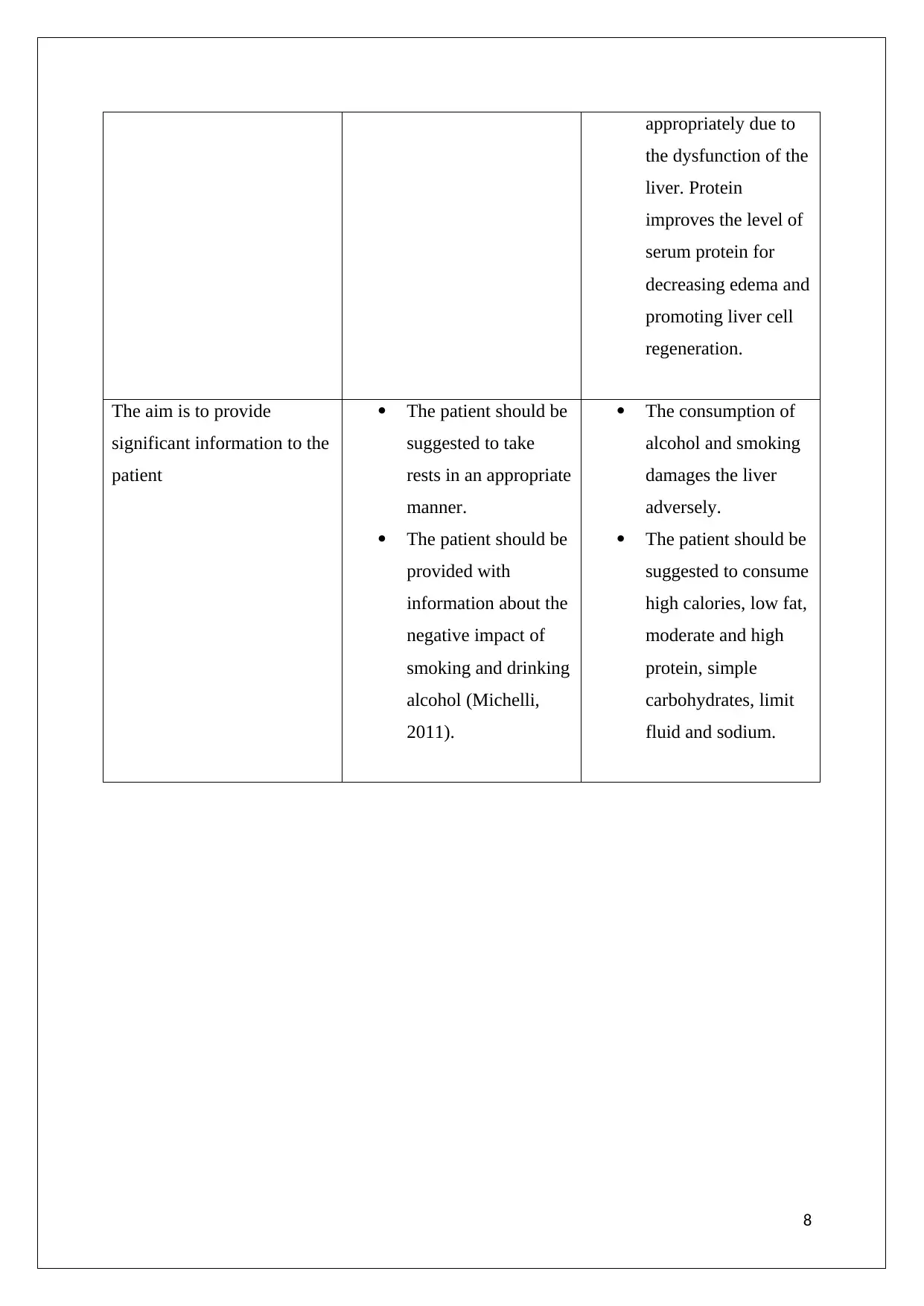
appropriately due to
the dysfunction of the
liver. Protein
improves the level of
serum protein for
decreasing edema and
promoting liver cell
regeneration.
The aim is to provide
significant information to the
patient
The patient should be
suggested to take
rests in an appropriate
manner.
The patient should be
provided with
information about the
negative impact of
smoking and drinking
alcohol (Michelli,
2011).
The consumption of
alcohol and smoking
damages the liver
adversely.
The patient should be
suggested to consume
high calories, low fat,
moderate and high
protein, simple
carbohydrates, limit
fluid and sodium.
8
the dysfunction of the
liver. Protein
improves the level of
serum protein for
decreasing edema and
promoting liver cell
regeneration.
The aim is to provide
significant information to the
patient
The patient should be
suggested to take
rests in an appropriate
manner.
The patient should be
provided with
information about the
negative impact of
smoking and drinking
alcohol (Michelli,
2011).
The consumption of
alcohol and smoking
damages the liver
adversely.
The patient should be
suggested to consume
high calories, low fat,
moderate and high
protein, simple
carbohydrates, limit
fluid and sodium.
8
⊘ This is a preview!⊘
Do you want full access?
Subscribe today to unlock all pages.

Trusted by 1+ million students worldwide
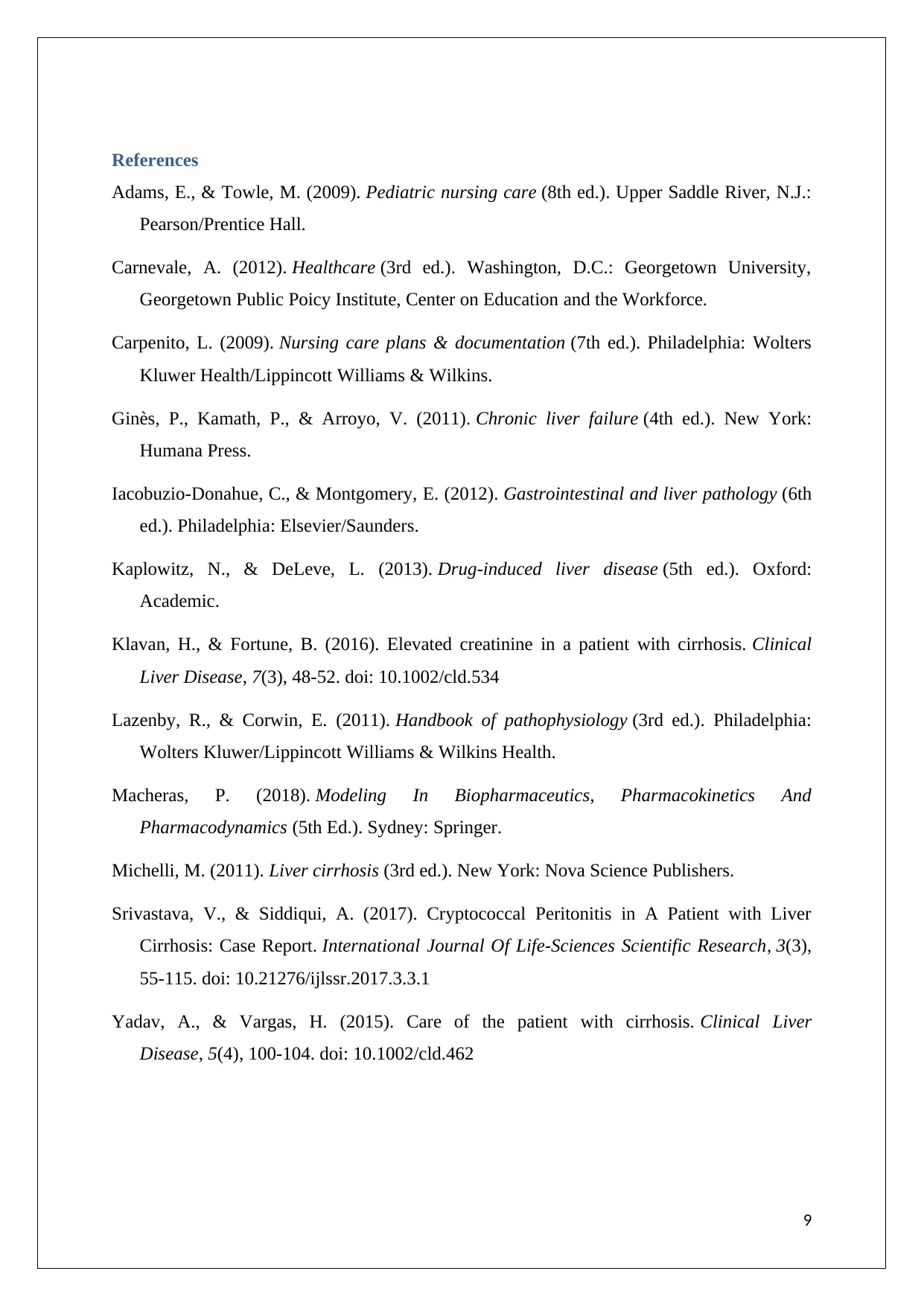
References
Adams, E., & Towle, M. (2009). Pediatric nursing care (8th ed.). Upper Saddle River, N.J.:
Pearson/Prentice Hall.
Carnevale, A. (2012). Healthcare (3rd ed.). Washington, D.C.: Georgetown University,
Georgetown Public Poicy Institute, Center on Education and the Workforce.
Carpenito, L. (2009). Nursing care plans & documentation (7th ed.). Philadelphia: Wolters
Kluwer Health/Lippincott Williams & Wilkins.
Ginès, P., Kamath, P., & Arroyo, V. (2011). Chronic liver failure (4th ed.). New York:
Humana Press.
Iacobuzio-Donahue, C., & Montgomery, E. (2012). Gastrointestinal and liver pathology (6th
ed.). Philadelphia: Elsevier/Saunders.
Kaplowitz, N., & DeLeve, L. (2013). Drug-induced liver disease (5th ed.). Oxford:
Academic.
Klavan, H., & Fortune, B. (2016). Elevated creatinine in a patient with cirrhosis. Clinical
Liver Disease, 7(3), 48-52. doi: 10.1002/cld.534
Lazenby, R., & Corwin, E. (2011). Handbook of pathophysiology (3rd ed.). Philadelphia:
Wolters Kluwer/Lippincott Williams & Wilkins Health.
Macheras, P. (2018). Modeling In Biopharmaceutics, Pharmacokinetics And
Pharmacodynamics (5th Ed.). Sydney: Springer.
Michelli, M. (2011). Liver cirrhosis (3rd ed.). New York: Nova Science Publishers.
Srivastava, V., & Siddiqui, A. (2017). Cryptococcal Peritonitis in A Patient with Liver
Cirrhosis: Case Report. International Journal Of Life-Sciences Scientific Research, 3(3),
55-115. doi: 10.21276/ijlssr.2017.3.3.1
Yadav, A., & Vargas, H. (2015). Care of the patient with cirrhosis. Clinical Liver
Disease, 5(4), 100-104. doi: 10.1002/cld.462
9
Adams, E., & Towle, M. (2009). Pediatric nursing care (8th ed.). Upper Saddle River, N.J.:
Pearson/Prentice Hall.
Carnevale, A. (2012). Healthcare (3rd ed.). Washington, D.C.: Georgetown University,
Georgetown Public Poicy Institute, Center on Education and the Workforce.
Carpenito, L. (2009). Nursing care plans & documentation (7th ed.). Philadelphia: Wolters
Kluwer Health/Lippincott Williams & Wilkins.
Ginès, P., Kamath, P., & Arroyo, V. (2011). Chronic liver failure (4th ed.). New York:
Humana Press.
Iacobuzio-Donahue, C., & Montgomery, E. (2012). Gastrointestinal and liver pathology (6th
ed.). Philadelphia: Elsevier/Saunders.
Kaplowitz, N., & DeLeve, L. (2013). Drug-induced liver disease (5th ed.). Oxford:
Academic.
Klavan, H., & Fortune, B. (2016). Elevated creatinine in a patient with cirrhosis. Clinical
Liver Disease, 7(3), 48-52. doi: 10.1002/cld.534
Lazenby, R., & Corwin, E. (2011). Handbook of pathophysiology (3rd ed.). Philadelphia:
Wolters Kluwer/Lippincott Williams & Wilkins Health.
Macheras, P. (2018). Modeling In Biopharmaceutics, Pharmacokinetics And
Pharmacodynamics (5th Ed.). Sydney: Springer.
Michelli, M. (2011). Liver cirrhosis (3rd ed.). New York: Nova Science Publishers.
Srivastava, V., & Siddiqui, A. (2017). Cryptococcal Peritonitis in A Patient with Liver
Cirrhosis: Case Report. International Journal Of Life-Sciences Scientific Research, 3(3),
55-115. doi: 10.21276/ijlssr.2017.3.3.1
Yadav, A., & Vargas, H. (2015). Care of the patient with cirrhosis. Clinical Liver
Disease, 5(4), 100-104. doi: 10.1002/cld.462
9
1 out of 10
Related Documents
Your All-in-One AI-Powered Toolkit for Academic Success.
+13062052269
info@desklib.com
Available 24*7 on WhatsApp / Email
![[object Object]](/_next/static/media/star-bottom.7253800d.svg)
Unlock your academic potential
Copyright © 2020–2025 A2Z Services. All Rights Reserved. Developed and managed by ZUCOL.





